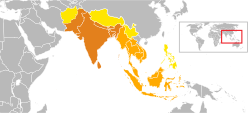Indianized kingdoms
The term Greater India is most commonly used to encompass the historical and geographic extent of all political entities of the Indian subcontinent, and the regions which are culturally linked to India or received significant Indian cultural influence. It had to varying degrees been transformed by the acceptance and induction of cultural and institutional elements of India. Since around 500 BCE, Asia's expanding land and maritime trade had resulted in prolonged socio-economic and cultural stimulation and diffusion of Hindu and Buddhist beliefs into the region's cosmology, in particular in Southeast Asia and Sri Lanka. In Central Asia, transmission of ideas were predominantly of a religious nature.
By the early centuries of the common era most of the principalities of Southeast Asia had effectively absorbed defining aspects of Hindu culture, religion and administration. The notion of divine god-kingship was introduced by the concept of Harihara, Sanskrit and other Indian epigraphic systems were declared official, like those of the south Indian Pallava dynasty and Chalukya dynasty. These Indianized Kingdoms, a term coined by George Cœdès were characterized by surprising resilience, political integrity and administrative stability.
To the north, Indian religious ideas were accepted into the cosmology of Himalayan peoples, most profoundly in Tibet and Bhutan. Buddhist monasticism extended into Afghanistan, Uzbekistan and other parts of Central Asia, and Buddhist texts and ideas were readily accepted in China and Japan in the east. To the west, Indian culture converged with Greater Persia via the Hindukush and the Pamir Mountains.
The concept of the Three Indias was in common circulation in pre-industrial Europe. Greater India was the southern part of South Asia, Lesser India was the northern part of South Asia, and Middle India was the region near the Middle East. The Portuguese form (Portuguese: India Maior) was used at least since the mid-15th century. The term, which seems to have been used with variable precision, sometimes meant only the Indian subcontinent; Europeans used a variety of terms related to South Asia to designate the South Asian peninsula, including High India, Greater India, Exterior India and India aquosa.
...
Wikipedia

